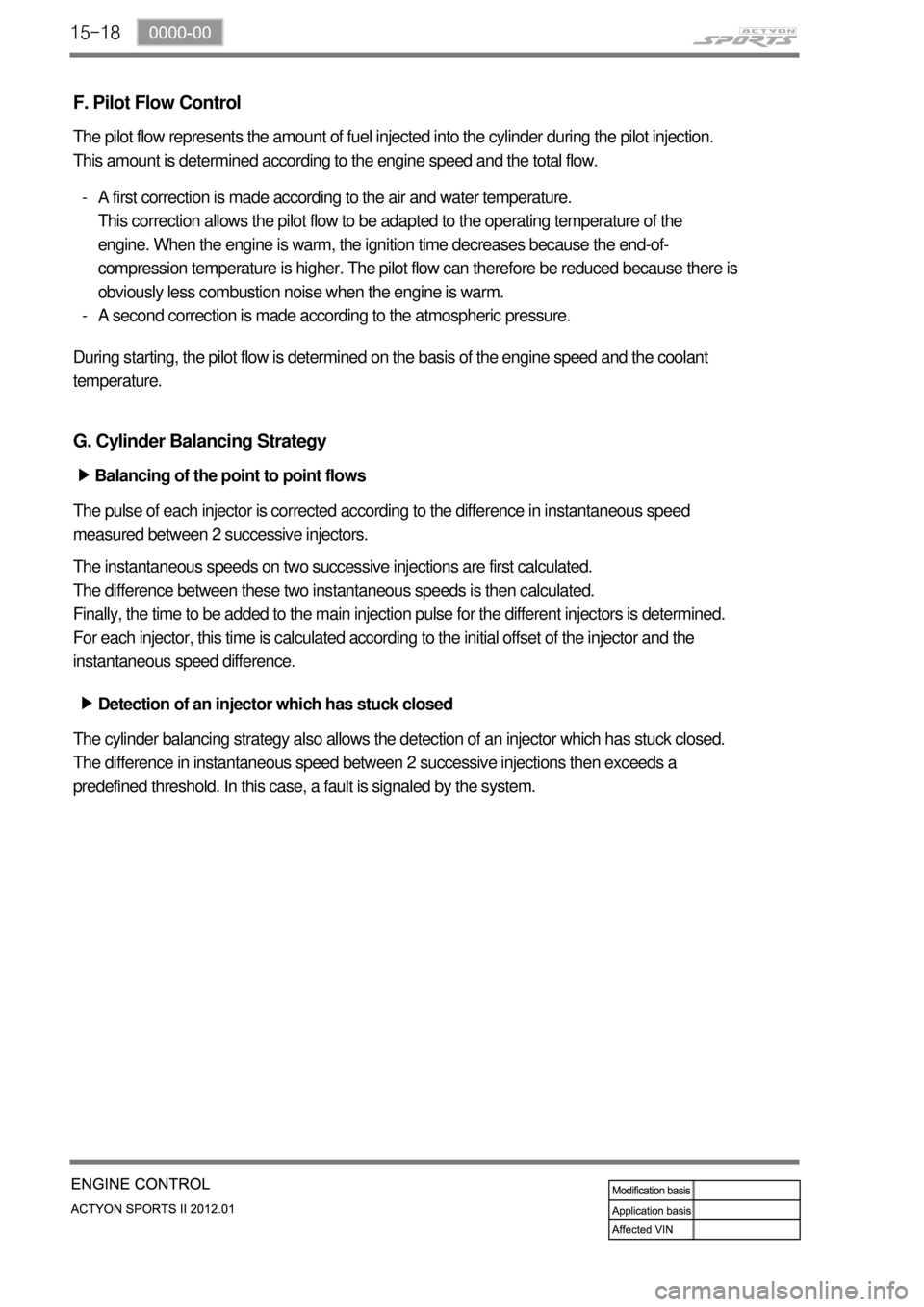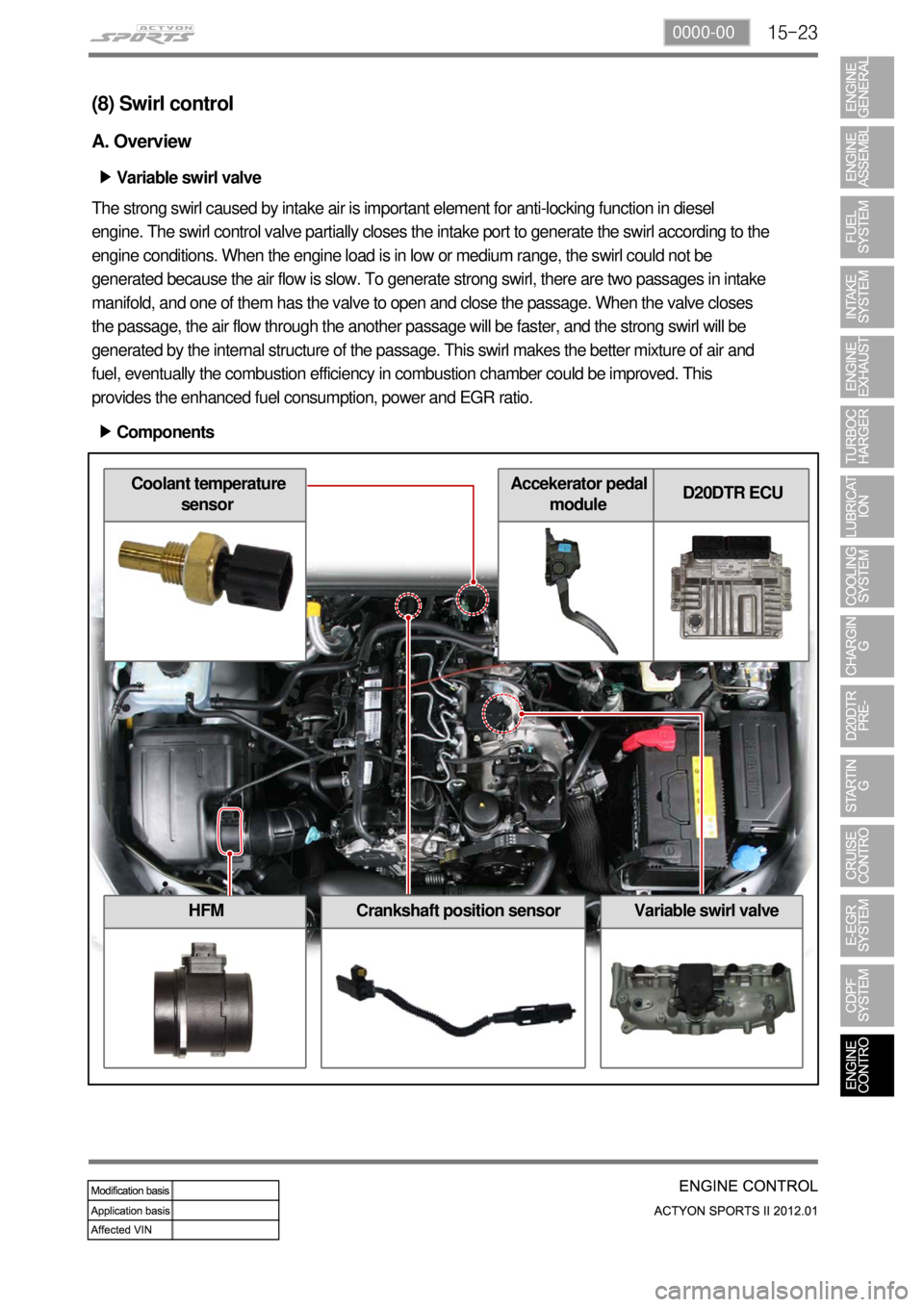Page 321 of 828

15-18
F. Pilot Flow Control
The pilot flow represents the amount of fuel injected into the cylinder during the pilot injection.
This amount is determined according to the engine speed and the total flow.
A first correction is made according to the air and water temperature.
This correction allows the pilot flow to be adapted to the operating temperature of the
engine. When the engine is warm, the ignition time decreases because the end-of-
compression temperature is higher. The pilot flow can therefore be reduced because there is
obviously less combustion noise when the engine is warm.
A second correction is made according to the atmospheric pressure. -
-
During starting, the pilot flow is determined on the basis of the engine speed and the coolant
temperature.
G. Cylinder Balancing Strategy
Balancing of the point to point flows ▶
The pulse of each injector is corrected according to the difference in instantaneous speed
measured between 2 successive injectors.
The instantaneous speeds on two successive injections are first calculated.
The difference between these two instantaneous speeds is then calculated.
Finally, the time to be added to the main injection pulse for the different injectors is determined.
For each injector, this time is calculated according to the initial offset of the injector and the
instantaneous speed difference.
Detection of an injector which has stuck closed ▶
The cylinder balancing strategy also allows the detection of an injector which has stuck closed.
The difference in instantaneous speed between 2 successive injections then exceeds a
predefined threshold. In this case, a fault is signaled by the system.
Page 323 of 828
15-20
C. Learning Conditions
Idle MDP learning Drive MDP learning
Coolant temperatureover 60℃ over 60℃
Vehicle speedIdling over 50km/h (over 5 seconds)
Engine rpm2,000 to 2,500 rpm
Fuel temperature0 < Fuel temperature < 80℃
Learning2 times for each cylinder (every
5 seconds)2 times for each cylinder
(every 5 seconds)
If MDP learning is not properly performed, engine vibration and injection could be occurred.
MDP learning should be performed after replacing ECU, reprogramming and replacing
injector. -
-
D. Injector characteristic curve for rail pressure
Page 326 of 828

15-230000-00
(8) Swirl control
A. Overview
Variable swirl valve ▶
The strong swirl caused by intake air is important element for anti-locking function in diesel
engine. The swirl control valve partially closes the intake port to generate the swirl according to the
engine conditions. When the engine load is in low or medium range, the swirl could not be
generated because the air flow is slow. To generate strong swirl, there are two passages in intake
manifold, and one of them has the valve to open and close the passage. When the valve closes
the passage, the air flow through the another passage will be faster, and the strong swirl will be
generated by the internal structure of the passage. This swirl makes the better mixture of air and
fuel, eventually the combustion efficiency in combustion chamber could be improved. This
provides the enhanced fuel consumption, power and EGR ratio.
Components ▶
HFMCrankshaft position sensorVariable swirl valve
Coolant temperature
sensorAccekerator pedal
moduleD20DTR ECU
Page 330 of 828
15-270000-00
(9) EGR control
A. Overview
The EGR (Electric-Exhaust Gas Recirculation) valve reduces the NOx emission level by
recirculating some of the exhaust gas to the intake system.
To meet Euro-V regulation, the capacity and response rate of E-EGR valve in D20DTR engine
have been greatly improved. The EGR cooler with high capacity reduces the Nox, and the bypass
valve reduces the CO and HC due to EGR gas before warming up.
Also, the engine ECU adjusts the E-EGR opening by using the air mass signal through HFM
sensor. If the exhaust gas gets into the intake manifold when the EGR valve is open, the amount
of fresh air through HFM sensor should be decresed.
B. Components
E-EGR cooler
Accelerator pedal
moduleD20DTR ECU
Coolant
temperature senso
r
Oxygen sensor
HFM (intake air
temperature)Electric throttle
body
Crankshaft position
sensor
E-EGR valve
T-MAP sensor
Page 332 of 828

15-290000-00
D. Bypass control for EGR cooler
Cooler temperature ▶
<007e008f008c00950047009b008f008c0047008a00960096009300880095009b0047009b008c00940097008c00990088009b009c0099008c00470090009a00470089008c00930096009e0047005e00570b4500530047009b008f008c0047008c009f008f00
88009c009a009b0047008e0088009a00470090009a00470089>ypassed the EGR cooler.
Exhaust gas temperature ▶
<007e008f008c00950047009b008f008c0047008c009f008f0088009c009a009b0047008e0088009a0047009b008c00940097008c00990088009b009c0099008c00470090009a00470089008c00930096009e0047005a005700570b4500530047009b008f00
8c0047008c009f008f0088009c009a009b0047008e0088009a> is bypassed the EGR cooler.
Otherwise, PM could be increased due to too low exhaust gas temperature.
E. Control elements for EGR system
Accelerator pedal (engine load) - Indicates the driver's intention and engine load. If the load
goes up, the EGR ratio is decreased.
T-MAP (boost pressure map stored in ECU) - Compensates the difference in boost pressure
by adjusting EGR ratio.
Engine rpm - Used as the signal for determining EGR operating range.
Coolant temperature - When the coolant temperature is low, NOx is decreased but PM could
be increased. So, to reduce PM, decrease EGR ratio when the coolant temperature is low.
Intake air mass and temperature - HFM sensor measures the intake air mass to calculate the
actual EGR volume. If the air mass is larger than programmed value in map, EGR ratio will be
higher.
EGR position sensor - Detects the actual opening angle of EGR valve and performs feedback
function according to PWM control by ECU.
Wide band oxygen sensor - Detects the oxygen volume in exhaust gas to check if the EGR
ratio is proper.
Electronic throttle body - Keeps EGR ratio to optimized level by controlling the throttle body in
EGR operating range (decreasing pressure in intake manifold). -
-
-
-
-
-
-
Page 334 of 828
15-310000-00
(10) E-VGT control
A. Overview
E-VGT (Electric-Variable Geometry Turbine) turbocharger system in D20DTF engine uses the
venturi effect that controls the flow rate of exhaust gas by adjusting the passage in turbine
housing. The newly adopted DC motor actuator (E-actuator) controls the E-VGT system more
precisely and faster. To get the high operating power from turbine, the ECU reduces the exhaust
gas passage In low speed range and increases it in high speed range.
B. Components
HFM (intake air
temperature)
Front EGT sensor
E-VGT actuatorAccelerator pedal
module
Crankshaft position
sensor
Oxygen sensor
T-MAP sensor
Coolant
temperature senso
r
D20DTR ECU
Page 336 of 828
15-330000-00
D. E-VGT system control
Turbocharger system operates the E-VGT actuator according to the signals for engine epm,
accelerator pedal position, atmospheric pressure, T-MAP, coolant temperature and intake air
temperature.
Turbocharger actuator is performed PWM control by ECU.
In general, the boost pressure feedbacks the turbocharger operation and the boost temperature is
used for calculating the precise density.
E-VGT provides higher engine power with faster reaction speed compared to conventional VGT.
Operating wave Vane Control
Low
speed
rangeIn low speed range:
retract the vane to
increase boost
pressure. The vane
has low (-) duty,
and the unison ring
moves to retract the
vane in weak PWM
signal.
High
speed
rangeThe unison ring
moves to extend the
vane in strong PWM
signal. Maximum
pressure is 3 bar
and the system
controls it according
to the input signals.
Page 337 of 828
15-34
HFM (intake air
temperature)CDPF
Electric throttle
bodyCoolant
temperature senso
r
Oxygen sensor
Injector (C3I)
E-EGR valve
(11) Wide band oxygen sensor control
A. Overview
For diesel engine, combustion is not performed at the optimum (theoretically correct) air-fuel ratio
and the oxygen concentration is thin in most cases. So the wide-band oxygen sensor is used for
this kind of engine, and this sensor is a little different from the one that used for gasoline engine.
The combustion in diesel engine is controlled by fuel injection volume. Therefore, the wide band
oxygen sensor should be used in diesel engine. This sensor measures the air-fuel ratio in very
wide range, and is also called full range oxygen sensor.
The wide band oxygen sensor measures the oxygen density in exhaust gas and sends it to
ECU to control the EGR more precisely. -
B. Components
D20DTR ECU